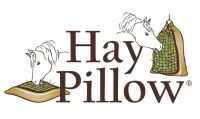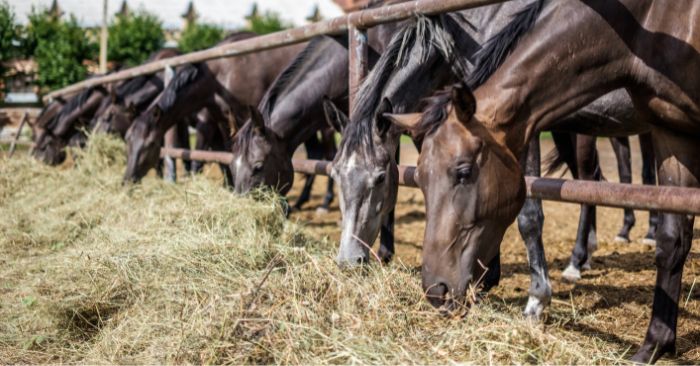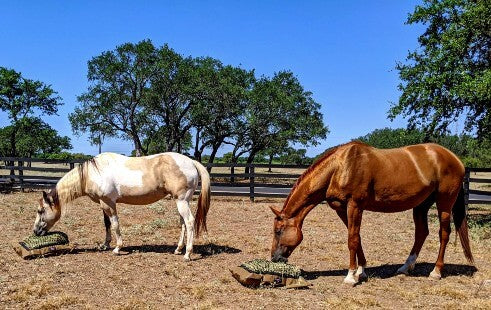Grass Hay vs Pellets, Cubes & Chopped Hay – Pros & Cons
Read on to learn the pros and cons of the various forms of grass hay.

Grass Hay - Pros
Higher Fiber Volume
- Maintain a healthy microbial population
- Promote gut motility
Maintains Lower Glucose Concentrations
If your horse is overweight or Insulin Resistant, a slow feeder paired with tested, low nonstructural carbohydrate grass hay (10% or less NSC’s) can help increase the fiber volume without increasing weight. Learn how to test your hay, where to send the sample and how to calculate NSCs using the results.
Easiest to Assess Quality
Increases Chew Time
Increased chew time also facilitates the natural wear of teeth when eating at ground level. A natural grazing position allows the mandible (jaw bone) to come down and forward in the atlantoaxial and temporomandibular joints. This enables the mandible to move up and down, side to side, forward and back without any restriction; facilitating optimum mastication and reduction of particle size.
Keeps Horses Warm in Cold Weather
Keeps Horses Occupied
Grass hay is a more convenient form of forage to offer in multiple locations by scattering piles of hay or multiple slow feeders. Multiple feeding stations keep your horse moving, which mimics grazing behavior and promotes gut motility.
Encourages Water Consumption
The minimum sodium requirements should be fed daily in supplements to encourage a natural thirst response.
Helps Prevent Gastric Ulcers
Foraging throughout the day and night maintains a higher (more alkaline) stomach pH because chewing and swallowing activate saliva production – which buffers gastric acid. Horses, donkeys and mules produce gastric acid continuously in preparation for constant uptake. The average 1,000 pound horse produces 16 gallons a day of gastric/hydrochloric acid. That equates to .66 gallons per hour (16 gallons divided by 24 hours).
The stomach only has a 2 to 4 gallon capacity and can begin to empty in as little as 15-20 minutes or when it becomes 2/3 full. If the stomach becomes empty, unbuffered gastric acid accumulates potentially burning holes in the stomach lining. Learn more: How Forage Buffers Acid.
Numerous Slow Feeder Options
Grass Hay - Cons
Waste
If you currently offer free choice loose hay, slow feeders with larger mesh sizes will dramatically reduce wasted hay and avoid frustration. Learn more: Choosing A Mesh Size.
Dental Challenges
Any condition causing pain can discourage the required chew time necessary for proper digestion. Optimal mastication (grinding) requires significant unobstructed motion of the jaw.
Miniature breeds are especially susceptible to genetic deformities. They have the same number of teeth, but whether they all fit in the reduced head size and line up properly is of concern. Find more suggestions for minis here: Feeding Miniature Horses & Donkeys: Why Slow Fed Forage is Best
Hay Pellets, Cubes & Chopped Hay - Pros
Alternative for Horses with Dental Challenges
Assist in Weight Gain or Maintenance for Horses on Grass Hay
Can Balance Nutrition
If good quality hay (protein, mineral and digestibility) is not available for individuals without dental challenges, cubes and chopped hay can be used as the core diet. Be sure to have hay available for additional chew time.
Ideal Carrier for Supplements
Hay Pellets, Cubes & Chopped Hay - Cons
Difficult to Assess Quality
- Color
- Dirt
- Stage of maturity at harvest
- Texture
- Presence of foreign material
- Mold
Most Contain Binding Agents
Hay pellets without binding agents are available. These use only steam and high pressure to form the pellets. Brands include Mountain Sunrise and Haystack.
Lower Saliva to Forage Ratios
If feeding pellets or cubes, soaking them prior to feeding is recommended. Soaking cubes or pellets one- to two-parts water to one part pellets or cubes for 20 minutes - 2 hours can help slow the rate of consumption and provide hydration.
If soaked in water, grass hay pellets typically expand 2 to 4 times in volume. The amount of expansion when soaked decreases relevant to the particle size. Cubes average 1.5 – 3 times in volume and chopped hay 1 – 1.5, respectively.
Note: Individuals with dental challenges may not be able to properly masticate dry dense pellets or cubes.
More Expensive
Challenging to Slow Down Consumption Rate
Bottom Line
- If your horse or herd do not have dental challenges, the best and least expensive form of forage is to provide pasture or baled grass hay as the core diet.
- For horses with dental challenges, soaked pellets, cubes or chopped hay may be your only option to provide a grass hay core diet.
Helpful How To Resources
- Sand Colic - The Surprising (Simple) Cure & Prevention
- Sugar Content of Pasture & Hay: Q & A with Katy Watts, Founder of Safergrass.org
- How & Where to Test Your Horse's Hay & Interpret Results
- Are You a Prisoner of Feeding? Here's How I Broke Free
- Ulcers? Learn How Forage Buffers Acid
- Causes of Equine Ulcers – 7 Stress Factors & Solutions
- 6 Great Reasons to Feed Your Horse from Ground Level
- 9 Benefits of Slow Feeding Horses
- 7 Slow Feed Dos and Dont's for Horses
- 7 Easy Ways to Help Prevent Colic
- Never Exercise Horses on an Empty Stomach...Ever
- Why You Shouldn't Transport Horses On An Empty Stomach
- Keeping Horses Warm Naturally – Internally and Externally
- Why Most Horses Prefer to Eat Outside







1 Comment -
Patti McGuinn •
Your Hay Pillows are seriously the best way to feed horses. I have a stall bound horse recovering from laminitis and the bags are very close to actual grazing. No wasted hay/ cleaner stall. Win win!